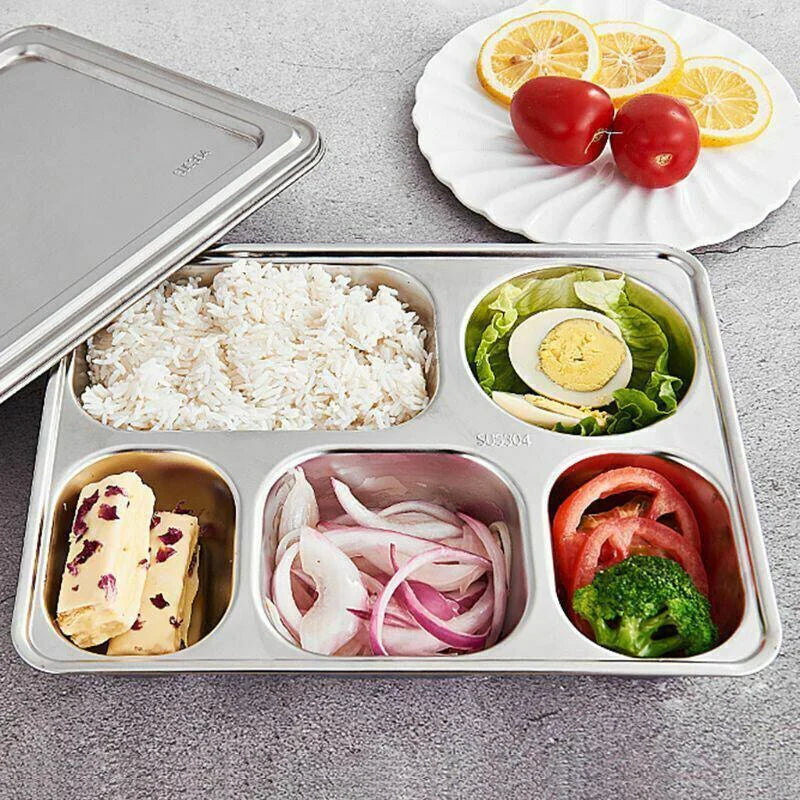Why are more and more people paying attention to compartment trays? From school canteens to home dining tables, from takeaway shops to outdoor camping, divided plates and trays have become a versatile and practical solution for modern lifestyles. Their simple design—a single tray split into multiple compartments—offers surprising advantages in nutrition, convenience, sustainability, and food presentation.
This article explores what compartment trays are, the different types available, their design logic, health and sustainability benefits, real-life applications, shopping tips, and even creative recipes. Whether you’re a parent, student, office worker, or restaurant manager, this guide will show you how divided trays can make meals easier, healthier, and more eco-friendly.

What Is a Compartment Tray?
-
Stainless Steel Divided Trays
-
Pros: Extremely durable, heat-resistant, hygienic, easy to clean, suitable for long-term use in schools, hospitals, or homes.
-
Cons: Heavier than plastic, not microwave-safe.
-
Example: Stainless Steel Divided Dinner Tray offers a classic multi-compartment design ideal for canteens or structured family meals.
-
-
Plastic / Polypropylene (PP) Trays
-
Pros: Lightweight, inexpensive, wide range of colors.
-
Cons: Not always microwave-safe, may stain or warp if exposed to high heat.
-
-
Melamine Trays
-
Pros: Durable, stylish, often used in restaurants and buffets, mimics ceramic.
-
Cons: Not suitable for high-heat cooking or microwaving.
-
-
Disposable Compostable Trays (Pulp or Bagasse)
-
Pros: Eco-friendly, compostable, ideal for takeaway or one-time events.
-
Cons: Single-use, less sturdy for liquids.
-
Example: Compartment Disposable Trays are perfect for eco-conscious catering and convenient takeaway meals.
-
-
Eco-Friendly Takeaway Containers
-
Pros: Compostable or recyclable, designed for modern food delivery.
-
Cons: Shorter lifespan than stainless steel or melamine.
-
Example: Eco-Friendly Takeaway Containers strike a balance between convenience and sustainability.
-
The Design Logic: Why Divided Compartments?
-
Visual & Cognitive Benefits: Divided spaces provide visual cues for portion sizes. By separating rice, vegetables, and protein, people naturally serve balanced amounts.
-
Flavor Protection: Keeps sauces, soups, and oily dishes from mixing into dry foods. No more soggy rice or salads drowned in curry sauce.
-
Operational Efficiency: In cafeterias, trays standardize serving portions, reduce line wait times, and simplify dishwashing.
-
Food Safety: Separate compartments minimize cross-contamination, particularly useful in institutional dining.

Health & Nutrition Benefits
Portion Control
-
½ vegetables
-
¼ protein
-
¼ grains or starches
Dietary Education
Specific Groups Benefiting
-
Weight management: Helps dieters stick to portion goals.
-
Diabetes and metabolic health: Supports controlled carbohydrate intake.
-
Children: Encourages variety, reduces picky eating.
-
Seniors: Easier to handle smaller, separated servings.
Sustainability & Cost Efficiency
-
Reduced Food Waste: Research shows that standardizing portions via divided trays can cut food waste in schools and canteens by reducing over-serving.
-
Eco-Friendly Materials: Stainless steel offers years of reuse; compostable pulp trays provide sustainable options for takeaways. Choosing the right material based on context maximizes environmental benefits.
-
Lifecycle Cost Comparison: A stainless steel tray may cost more upfront but lasts years, while disposables are cheaper for events but generate recurring expenses.
Creative Recipes & Plating Ideas
Example Menus:
-
Balanced Office Lunch
-
Rice (1 cup)
-
Grilled chicken breast (150g)
-
Stir-fried vegetables (½ cup)
-
Salad greens (½ cup)
-
-
Kids’ Colorful Plate
-
Mac & cheese (small portion)
-
Steamed broccoli
-
Fruit salad
-
-
Low-Carb Dinner
-
Grilled salmon
-
Cauliflower rice
-
Roasted zucchini & carrots
-
-
Outdoor Camping Meal
-
Bread roll
-
Chili con carne
-
Fresh salad
-

